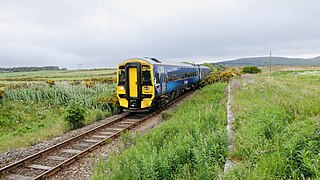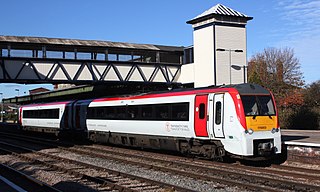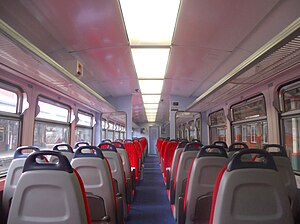A train operating company (TOC) is the term used on the railway system of Great Britain for a railway undertaking operating passenger trains under the collective National Rail brand. TOCs have existed since the privatisation of the network under the Railways Act 1993.

The British Rail Class 156 Super Sprinter is a diesel multiple unit passenger train. A total of 114 sets were built between 1987 and 1989 for British Rail by Metro-Cammell's Washwood Heath works. They were built to replace elderly first-generation DMUs and locomotive-hauled passenger trains.

The British Rail Class 360 Desiro is an electric multiple unit class that was built by Siemens Transportation Systems between 2002 and 2005. The Class 360 is currently operated by East Midlands Railway and the Global Centre of Rail Excellence.

The British Rail Class 170 Turbostar is a British diesel multiple unit (DMU) passenger train designed and built by Adtranz, and later by Bombardier Transportation, at Derby Litchurch Lane Works.

The British Rail Class 158Express Sprinter is a diesel multiple unit (DMU) passenger train. It is a member of the Sprinter series of regional trains, produced as a replacement for British Rail's first generation of DMUs; of the other members, the Class 159 is almost identical to the Class 158, having been converted from Class 158 to Class 159 in two batches to operate express services from London Waterloo to the West of England.

The British Rail Class 180 is a class of 14 diesel-hydraulic multiple unit passenger trains manufactured by Alstom at its Washwood Heath factory in 2000/01 for First Great Western (FGW). They are part of the Coradia 1000 family, along with the Class 175.

The British Rail Class 317 is an electric multiple unit (EMU) passenger train constructed by British Rail Engineering Limited in two batches: 48 sets were produced in 1981–82 and 24 sets in 1985–87. They were the first of several classes of British Rail EMU to be based on the all-steel Mark 3 bodyshell, departing from the PEP-aluminium design which had spawned the earlier Class 313 to Class 315, Class 507 and Class 508. The Mark 3 bodyshell was also the basis of Class 318, Class 455 and the diesel Class 150. The Class 317 uses overhead alternating current electrification. All units were withdrawn in July 2022.

The British Rail Mark 3 is a type of passenger carriage developed in response to growing competition from airlines and the car in the 1970s. A variant of the Mark 3 became the rolling stock for the High Speed Train (HST).

The British Rail Class 321 is a class of electric multiple unit (EMU) passenger train built by British Rail Engineering Limited's York Carriage Works in three batches between 1988 and 1991 for Network SouthEast and Regional Railways. The class uses alternating current (AC) overhead electrification. The design was successful and led to the development of the similar Class 320 and Class 322.

The British Rail Class 43 (HST) is the TOPS classification used for the InterCity 125 High Speed Train diesel-electric power cars, built by British Rail Engineering Limited from 1975 to 1982, and in service in the UK since 1976.

The British Rail Class 319 is an electric multiple unit passenger train built by British Rail Engineering Limited's Holgate Road carriage works for use on north–south cross-London services. These dual-voltage trains are capable of operating on 25 kV 50 Hz from AC overhead wires or 750 V DC from a third rail.

The British Rail Class 315 BEP is a fleet of alternating current (AC) electric multiple unit (EMU) trains, built by British Rail Engineering Limited at Holgate Road Carriage Works in York between 1980 and 1981; they replaced the Class 306 units. It was a variant of unit derived from British Rail's 1971 prototype suburban EMU design which, as the BREL 1972 family, eventually encompassed 755 vehicles across Classes 313, 314, 315, 507 and 508. Revenue services with Class 315 units commenced in 1980 and continued until December 2022.
Abellio is a Dutch public transport company that operates bus and rail services in Germany, and formerly also in Czech Republic, the Netherlands, and the United Kingdom. It is wholly owned by the Dutch national railway company, Nederlandse Spoorwegen (NS).

Greater Anglia is a British train operating company owned as a joint venture by Transport UK Group and Mitsui & Co. It operates the East Anglia franchise, providing the commuter and intercity services from its Central London terminus at London Liverpool Street to Essex, Suffolk, Norfolk and parts of Hertfordshire and Cambridgeshire as well as many regional services throughout the East of England.

Diesel multiple units and railcars are trains, usually with passenger accommodation, that do not require a locomotive. Railcars can be single cars, while in multiple units cars are marshalled together with a driving position either end. As of December 2010, 23 percent of the rail passenger cars used on Network Rail are part of a diesel multiple unit.

Abellio ScotRail, operating services under the name ScotRail, was the national train operating company of Scotland. A subsidiary of the Netherlands-based transport conglomerate Abellio, it operated the ScotRail franchise between 1 April 2015 and 31 March 2022.

West Midlands Trains (WMT) is a British train operating company. It operates passenger trains on the West Midlands franchise between London and the English Midlands under two trading names: within the West Midlands region as West Midlands Railway (WMR) and outside the region as London Northwestern Railway (LNR).

Keolis Amey Operations, trading as Transport for Wales Rail Services was a Welsh train operating company owned by Keolis (60%) and Amey (40%) that operated the Wales & Borders franchise between October 2018 and February 2021.

East Midlands Railway is a British train operating company owned by Transport UK Group, and is the current operator of the East Midlands franchise.

Northern Trains, trading as Northern, is a British train operating company owned by DfT OLR Holdings for the Department for Transport (DfT), after the previous operator Arriva Rail North had its franchise terminated at the end of February 2020.































